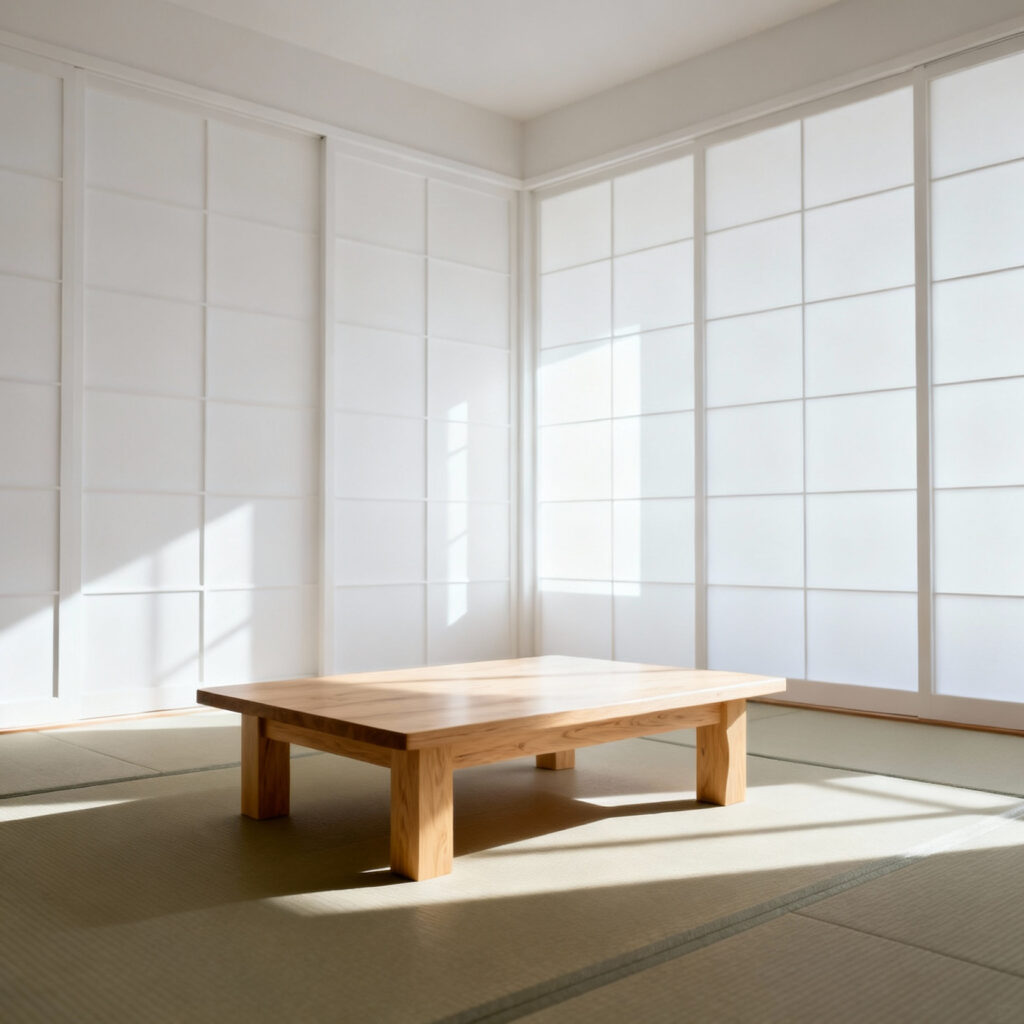The arrangement of a home is, at its heart, a form of poetry—every choice reflects not just an aesthetic preference, but a deeper value about how one wishes to live. The most compelling rooms aren’t decorated; they are authored. They speak of a quiet understanding that a home is not a stage for possessions, but a sanctuary for the self. These twenty contemplations separate a space that feels authentically serene from one that is merely arranged. This is not about having less, but about allowing what remains to have more meaning.
The Foundation: Cultivating a Philosophy of Space
Before a single piece of furniture is moved, the most profound work begins within. We must first establish an intentional framework, a philosophy rooted in principles that have guided architects and artisans for centuries. This is the bedrock upon which a truly simple living room decoration is built—not on trends, but on timeless wisdom.
1. Embracing Ma—The Art of the Meaningful Void
In traditional Japanese architecture, we are taught that the most vital element of design is often the space between things. This is Ma—the active, potent void. It is not emptiness, but a deliberate pause that gives every object its presence and power. Think of it as the silence that gives music its form.
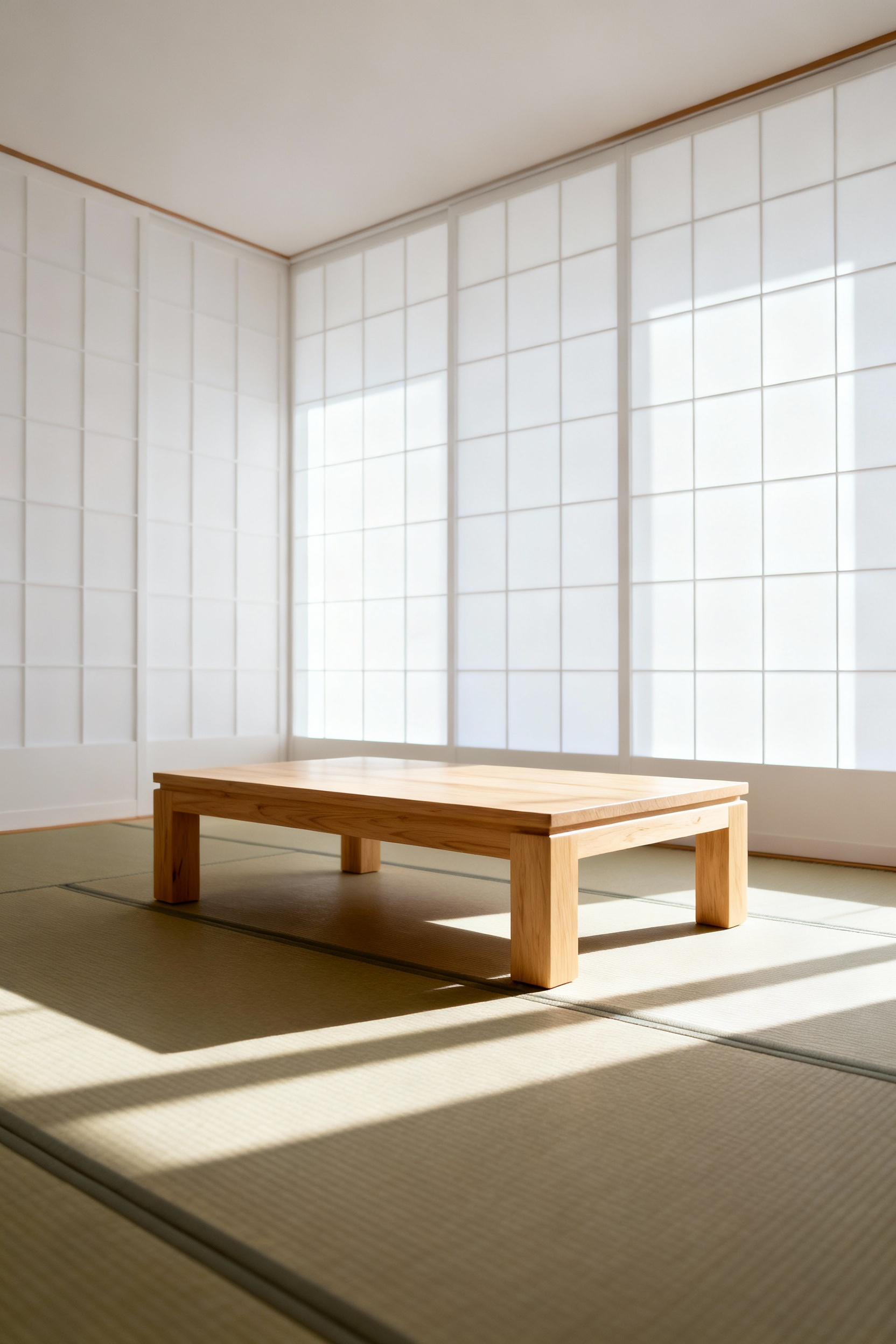
Applying Ma is an act of profound restraint. Instead of asking what you can add, ask what can exist in its own generous space. A single, beautiful armchair is given its due when surrounded by quiet openness. This allows the living room to breathe, making even a small space feel expansive and calm, and guiding the eye toward what is truly essential.
2. Seeking Kanso—Clarity Through Functional Purity
Kanso is the principle of simplicity, but not a cold or sterile one. It is the clarity that emerges when everything non-essential has been stripped away, revealing an object’s true purpose and form. This is elegance born from honesty.
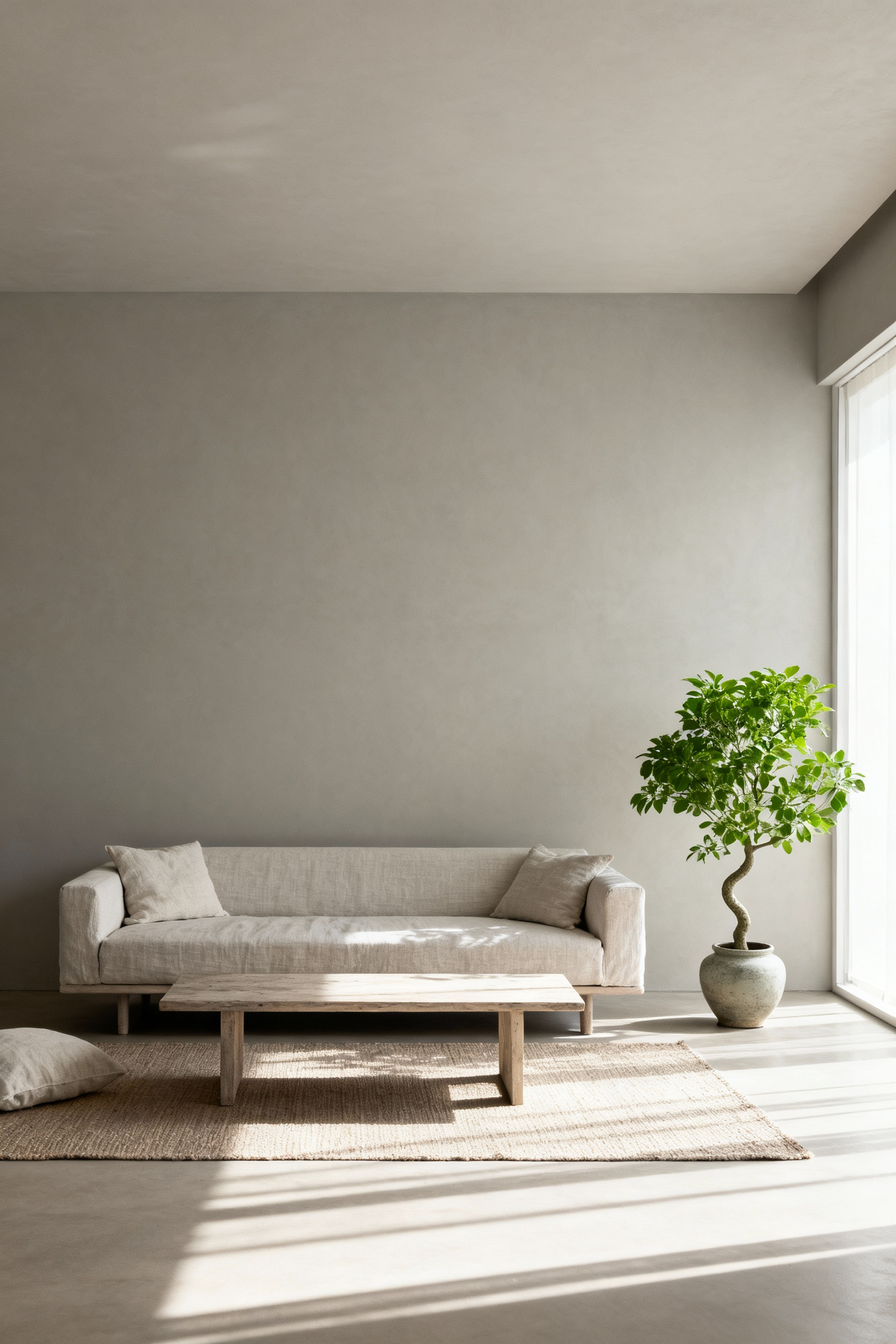
I’ve noticed that homes embodying Kanso feel incredibly peaceful because nothing is competing for attention. A sofa is chosen for its clean lines and enduring comfort, a table for its direct function and honest materials. It means integrated storage that allows clutter to disappear, preserving the visual calm. Every item must justify its existence through both beauty and utility.
3. Finding Seijaku—An Active and Intentional Calm
While it translates to tranquility, Seijaku is not a passive state. It is an active, profound calm achieved through mindful balance. In our increasingly noisy world, designing for Seijaku means creating an environment that actively soothes the senses and encourages inner quiet.
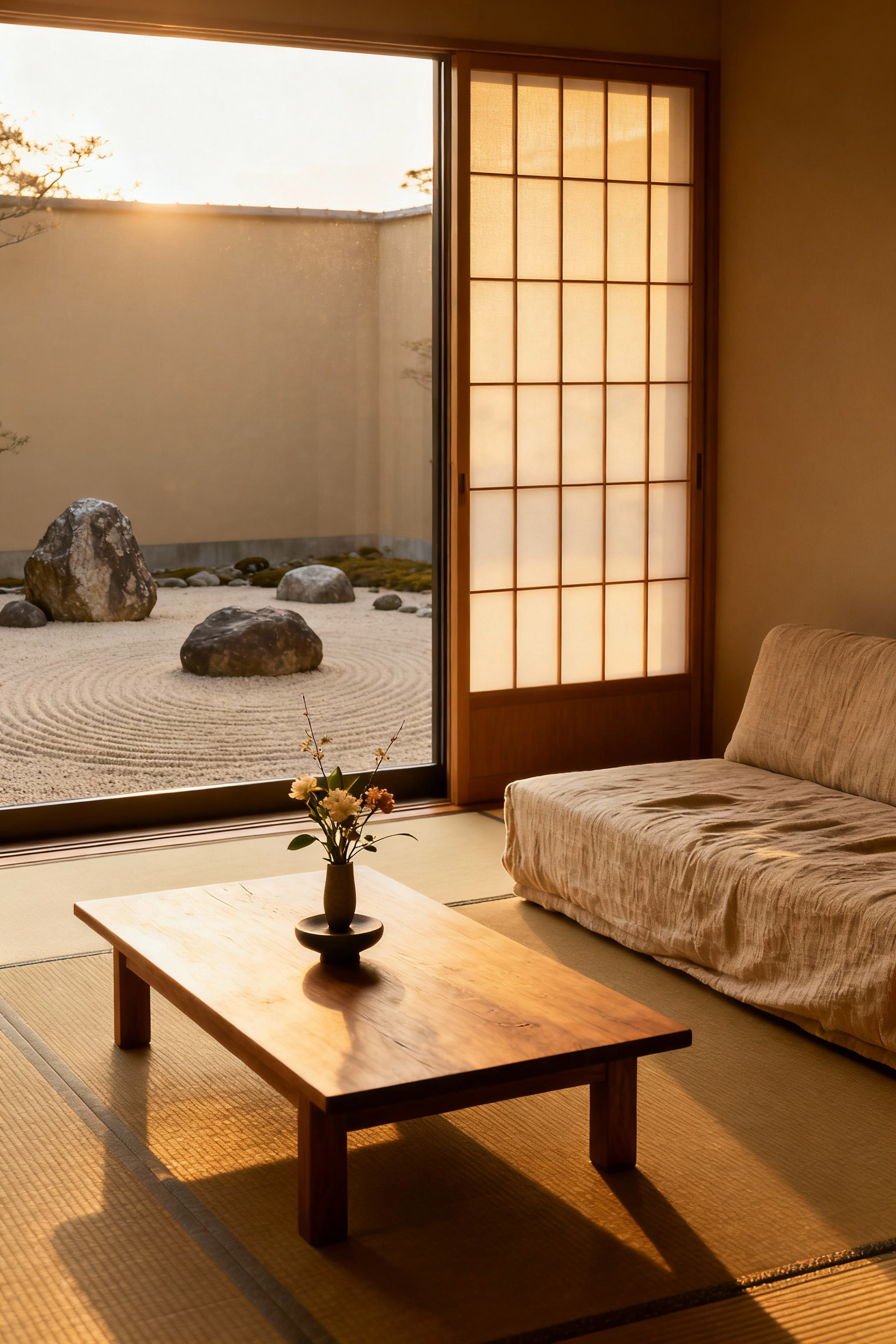
This translates to soft, diffused lighting that eliminates harsh shadows and a palette of muted, natural colors that don’t jolt the eye. Here’s what’s interesting—it also involves acoustics. Soft textiles like wool rugs and linen curtains absorb sound, creating a palpable stillness. A room that embodies Seijaku becomes a true refuge, a place that calms you the moment you enter.
4. Appreciating Shibumi—The Beauty of Understated Excellence
Shibumi describes a refined, unostentatious beauty that reveals its depth over time. It is an elegance that doesn’t announce itself but is discovered through quiet contemplation. It is the perfect ceramic bowl that feels just right in your hands, its simple form the result of masterful skill.
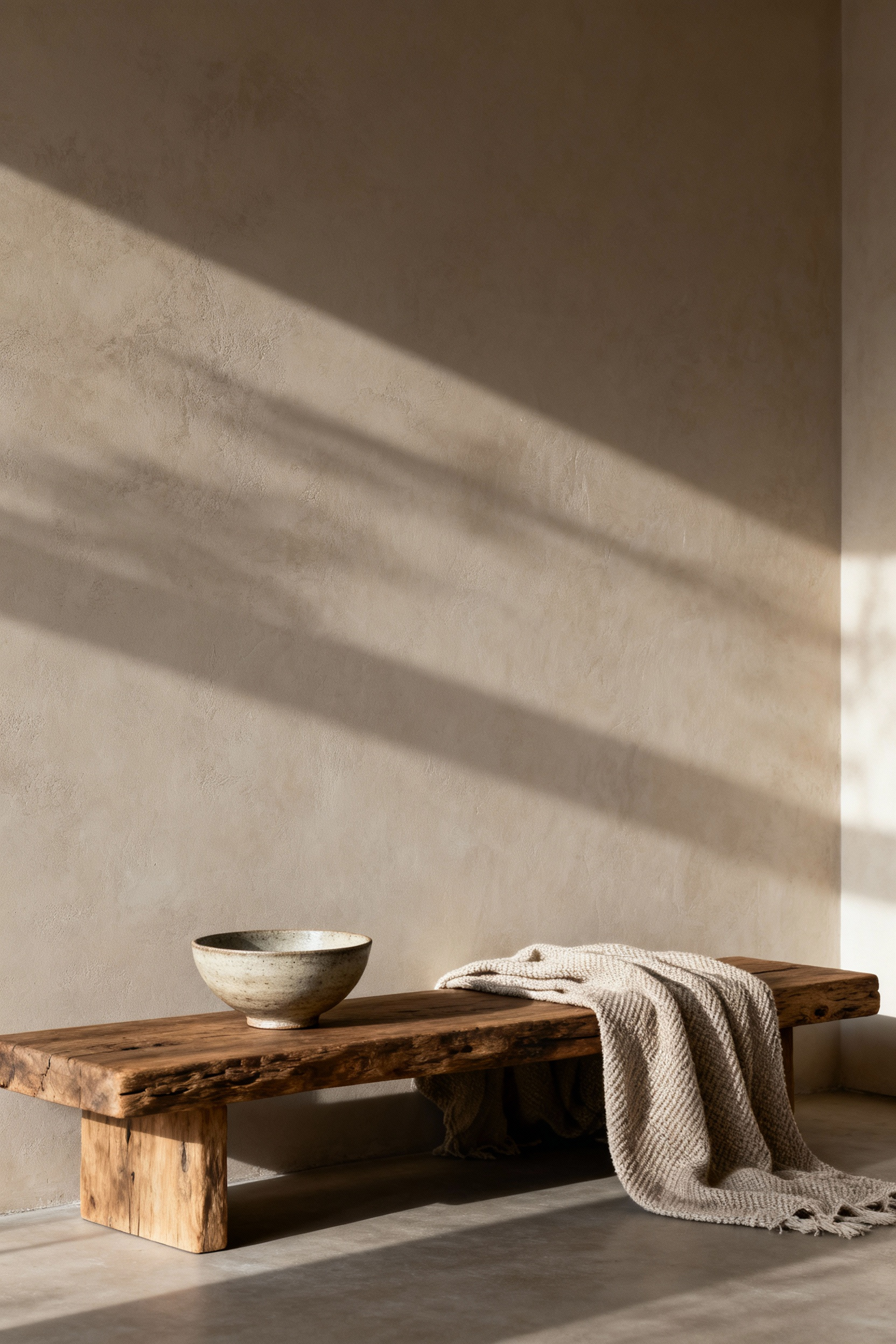
To practice Shibumi is to choose objects for their inherent quality and quiet dignity. It is a commitment to craftsmanship over branding. In a living room, this could be a side table with flawless traditional joinery or a lamp whose simple form produces the most perfect, warm glow. The beauty is in the details that you may be the only one to notice.
5. Achieving Fukinsei—The Balance of Asymmetry
Nature is rarely symmetrical, and in its asymmetry lies a dynamic, living beauty. Fukinsei celebrates this principle, advocating for a balance achieved through irregularity. A perfectly symmetrical room can feel static and lifeless; introducing intentional asymmetry creates interest and flow.
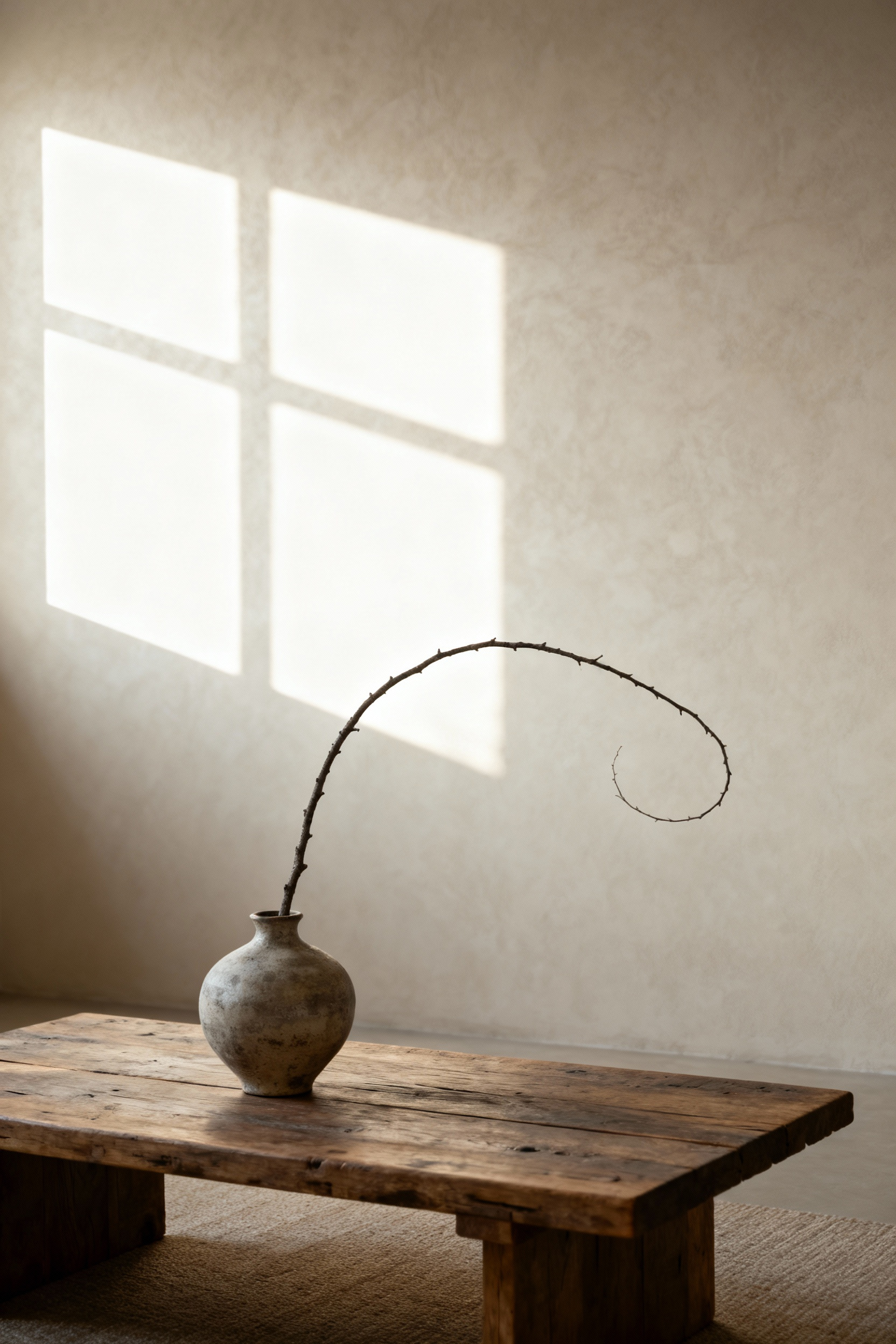
This might mean placing a single floor lamp next to a sofa rather than a pair of matching end tables. Or arranging a collection of three vessels of varying heights instead of a single, centered object. From my work in Japanese aesthetics, I know this creates a subtle visual tension that engages the eye and feels more natural, more like life itself.
The Dialogue: Sensory Layers and Natural Resonances
A serene space speaks to us through more than just its visual arrangement. It engages all our senses in a quiet dialogue. The feel of wood, the softness of light, the texture of fabric—these are the elements that transform a room into a holistic experience.
6. Orchestrating a Monochromatic Palette for Visual Rest
A monochromatic palette is not about a lack of color, but a deep exploration of a single hue. By using varying shades, tints, and textures of one color family—be it a series of warm greys or earthy beiges—you create an immediate sense of cohesion and calm. The eye is not forced to jump between competing colors; it can rest.
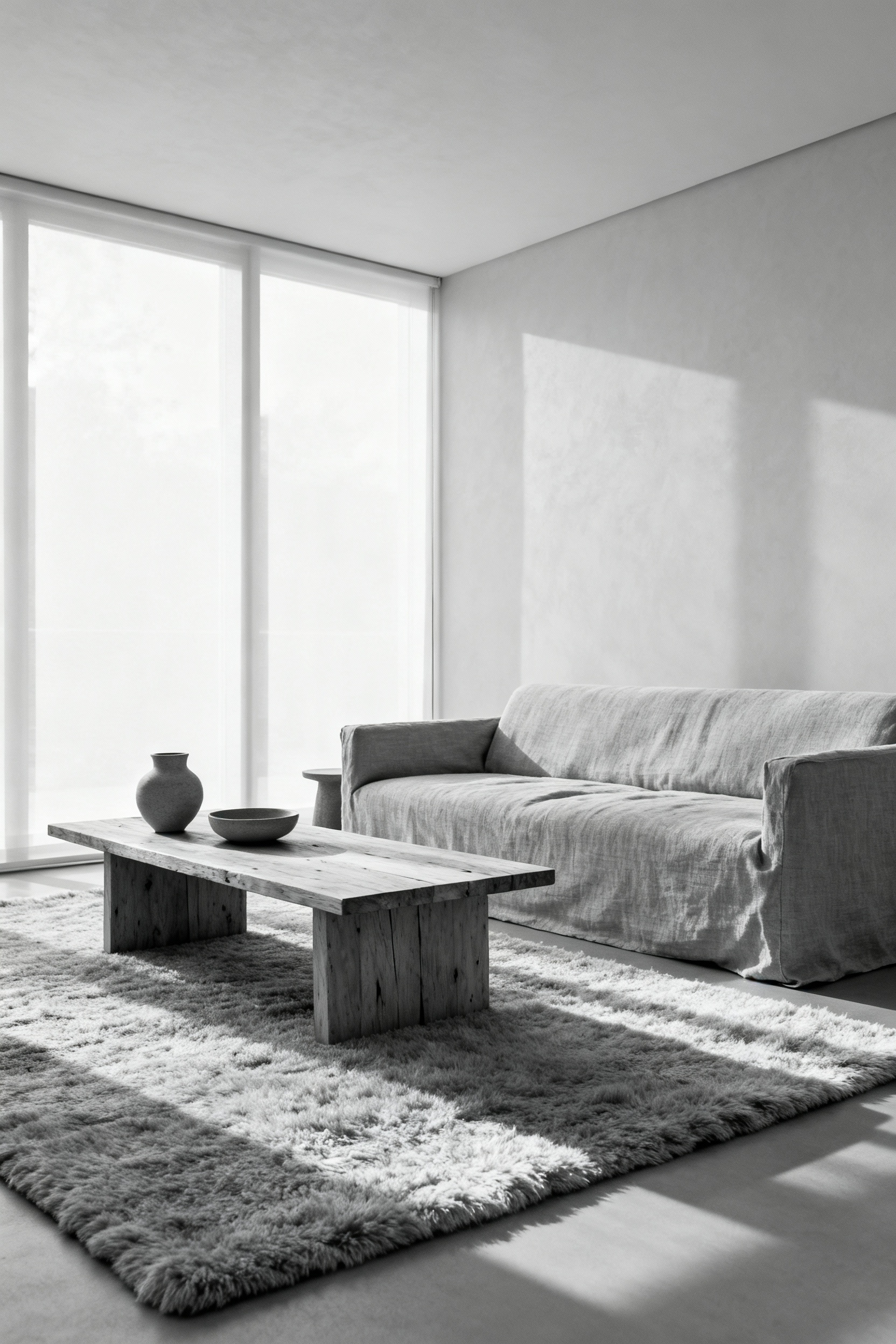
This visual quiet serves as a canvas. When the background is harmonious, the texture of a linen sofa, the grain of a wooden bowl, or the vibrant green of a single plant can emerge with incredible clarity. It’s a discipline that elevates the inherent beauty of your chosen materials.
7. Infusing Tactile Warmth with Unfinished Wood and Natural Fibers
Our connection to a space becomes deeper when it engages our sense of touch. Raw, unfinished wood and natural fibers like linen, wool, and cotton ground us. These materials are honest; they carry the story of their origins and age with a grace that synthetic alternatives cannot mimic.
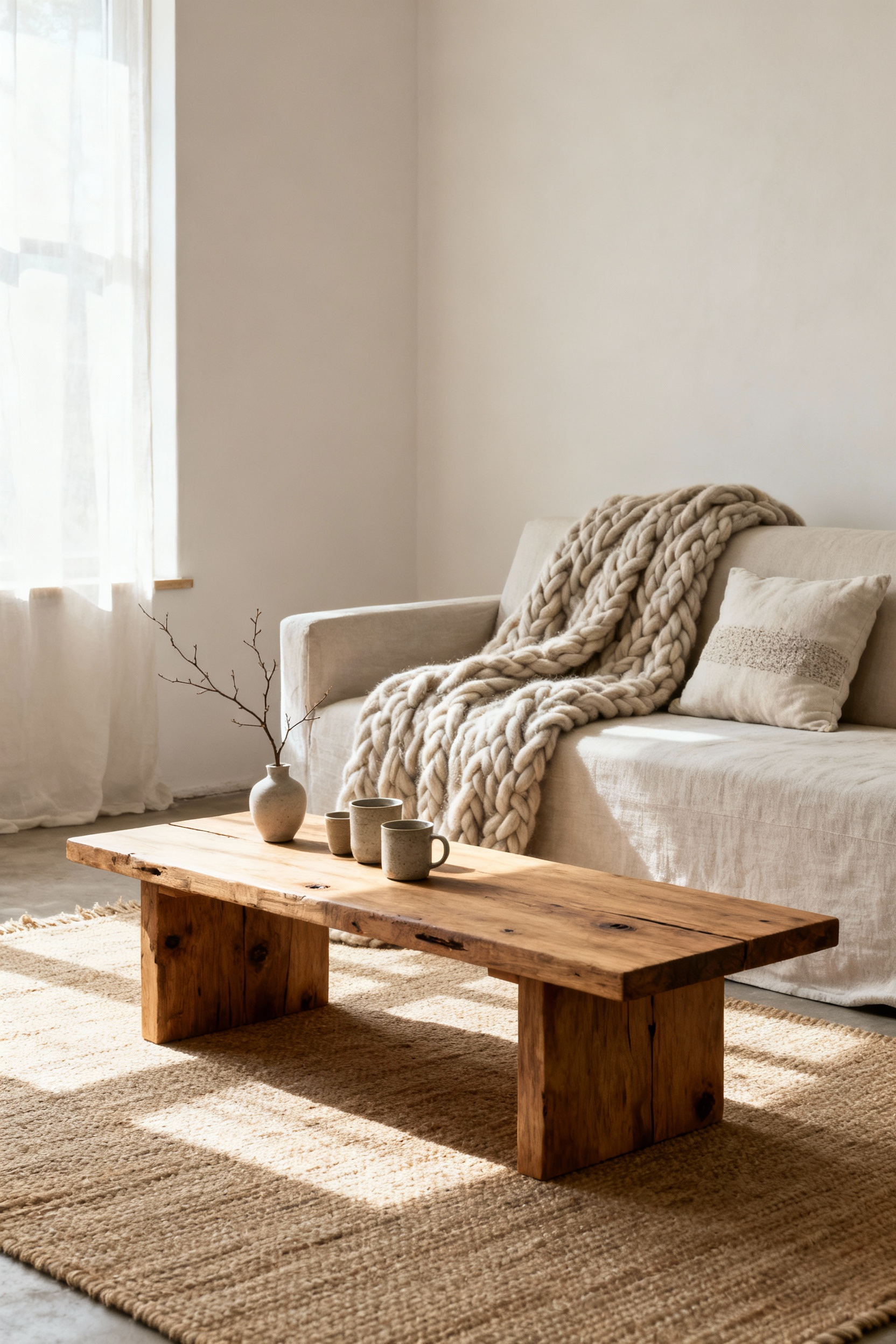
I always advise clients to consider how things feel. A rough-hewn oak coffee table invites you to trace its grain. A hand-knotted jute rug provides a grounding texture underfoot. These are not just decorative choices; they are a way to bring the soothing, authentic presence of the natural world into your home.
8. Harnessing the Power of Diffused Natural Light
Light is arguably the most powerful design element we have, and natural light is the most precious. The goal is not just to have light, but to shape its quality. Diffused light—softened as it passes through sheer linen curtains or shoji-inspired screens—removes harsh glare and creates a gentle, ethereal glow.
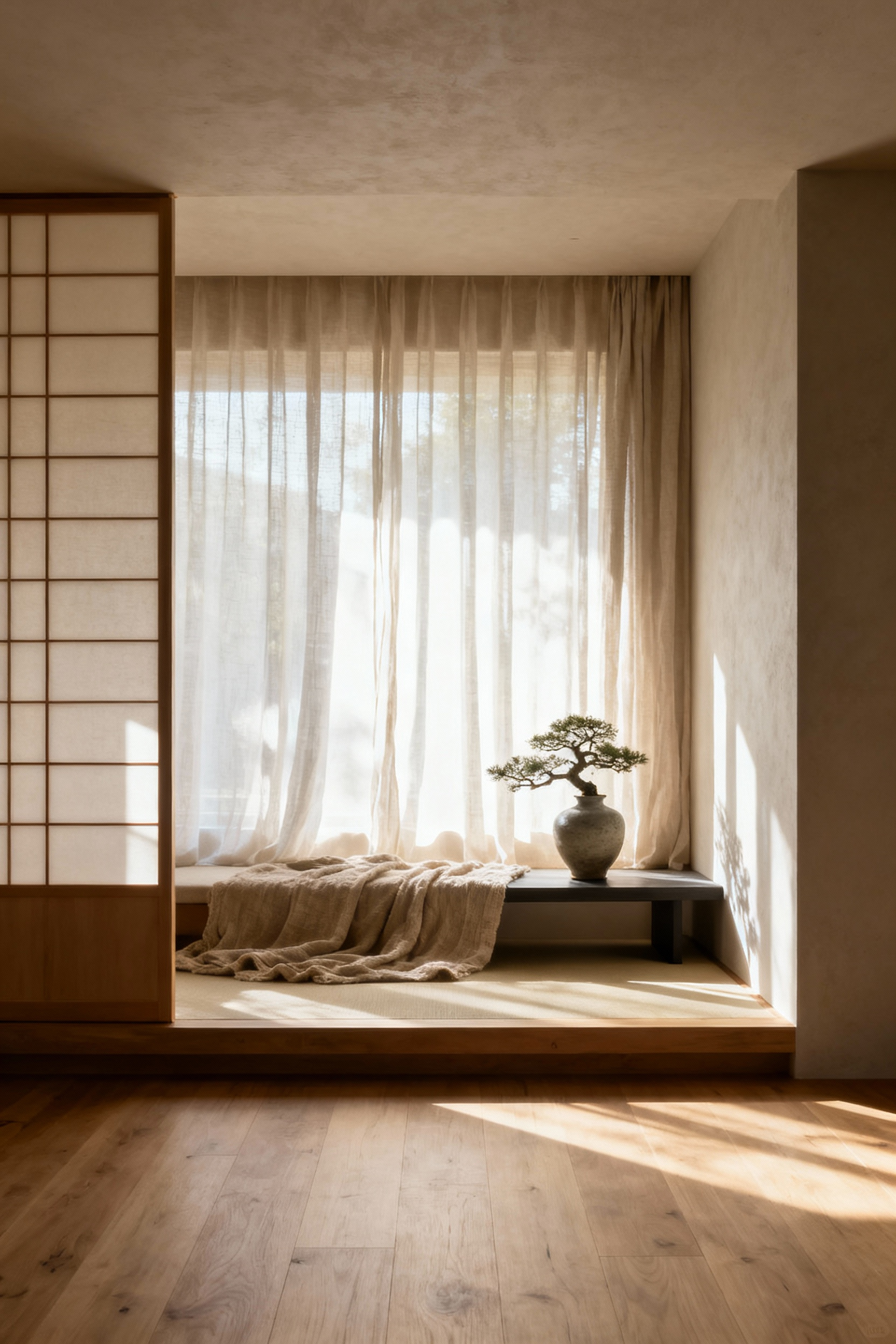
This soft luminescence is calming to our nervous system. It connects us to the rhythm of the day, shifting subtly from the cool light of morning to the warm tones of dusk. By designing with light in mind, we create a space that feels alive and attuned to the world outside.
9. Curating Textural Layers for Subtlety, Not Clutter
Texture is what gives a minimalist space its soul. The art is to layer different textures to create depth and warmth without adding visual clutter. A smooth leather chair, a chunky knit throw, a soft velvet pillow, and a polished concrete floor can all coexist beautifully within a simple palette.
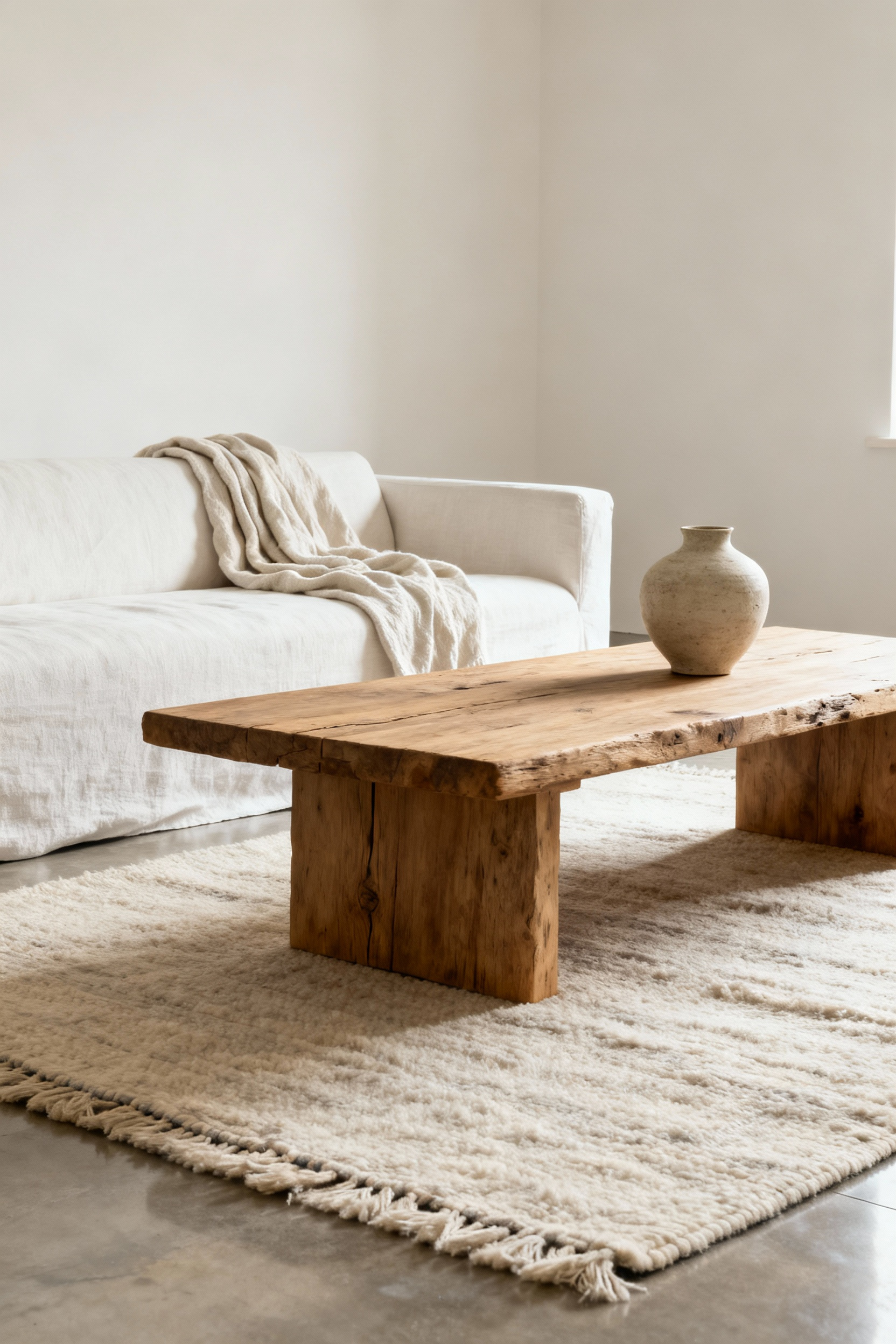
This layering creates a rich sensory experience. The interplay between rough and smooth, matte and gloss, invites touch and makes a space feel considered and deeply comfortable. What I tell my clients is that simplicity is not about absence, but about the richness of what is present.
10. Integrating Botanical Elements with Mindful Simplicity
A living element brings a unique vitality to a room. But instead of a jungle of houseplants, consider the practice of ikebana—the art of Japanese flower arrangement—which emphasizes form, line, and space. A single, sculptural branch in a simple ceramic vase can be more powerful than a large bouquet.
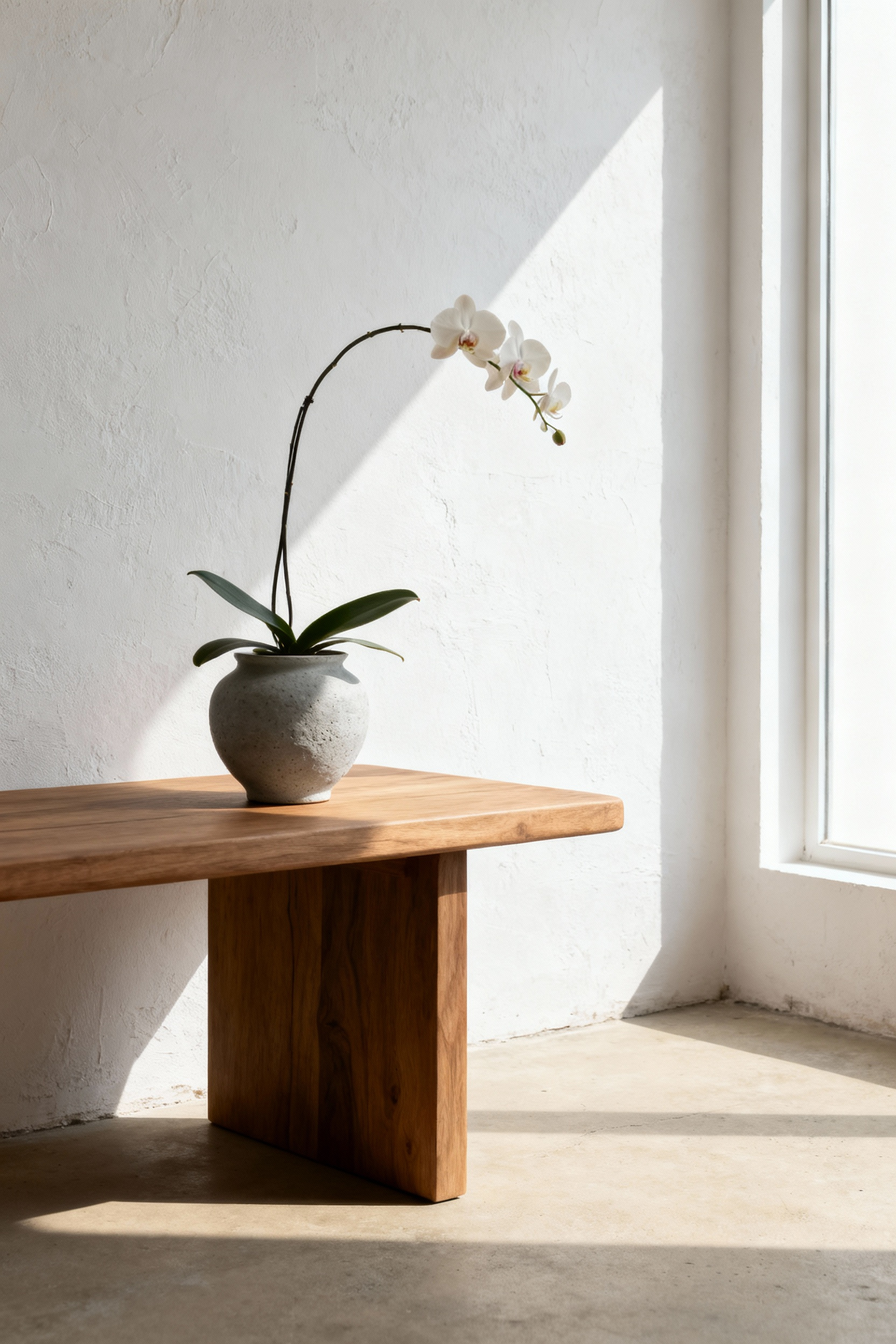
Choose plants for their form—the architectural lines of a snake plant or the delicate cascade of a string-of-pearls. Tending to this living thing becomes a small, meditative ritual, a reminder of the quiet, persistent rhythms of growth and nature within your home.
The Form: Orchestrating Flow and Quiet Function
The way a room is arranged dictates how we move, interact, and feel within it. A thoughtful layout is an invisible architecture that guides our experience, creating a sense of effortless flow and purpose. This is where function and aesthetics merge into a silent, harmonious dance.
11. Defining Conversational Zones with Strategic Groupings
Instead of pushing furniture against the walls, pull it into intimate, purposeful groupings that invite connection. Two chairs and a small table create a space for quiet conversation. A sofa facing an armchair fosters a welcoming atmosphere for guests.
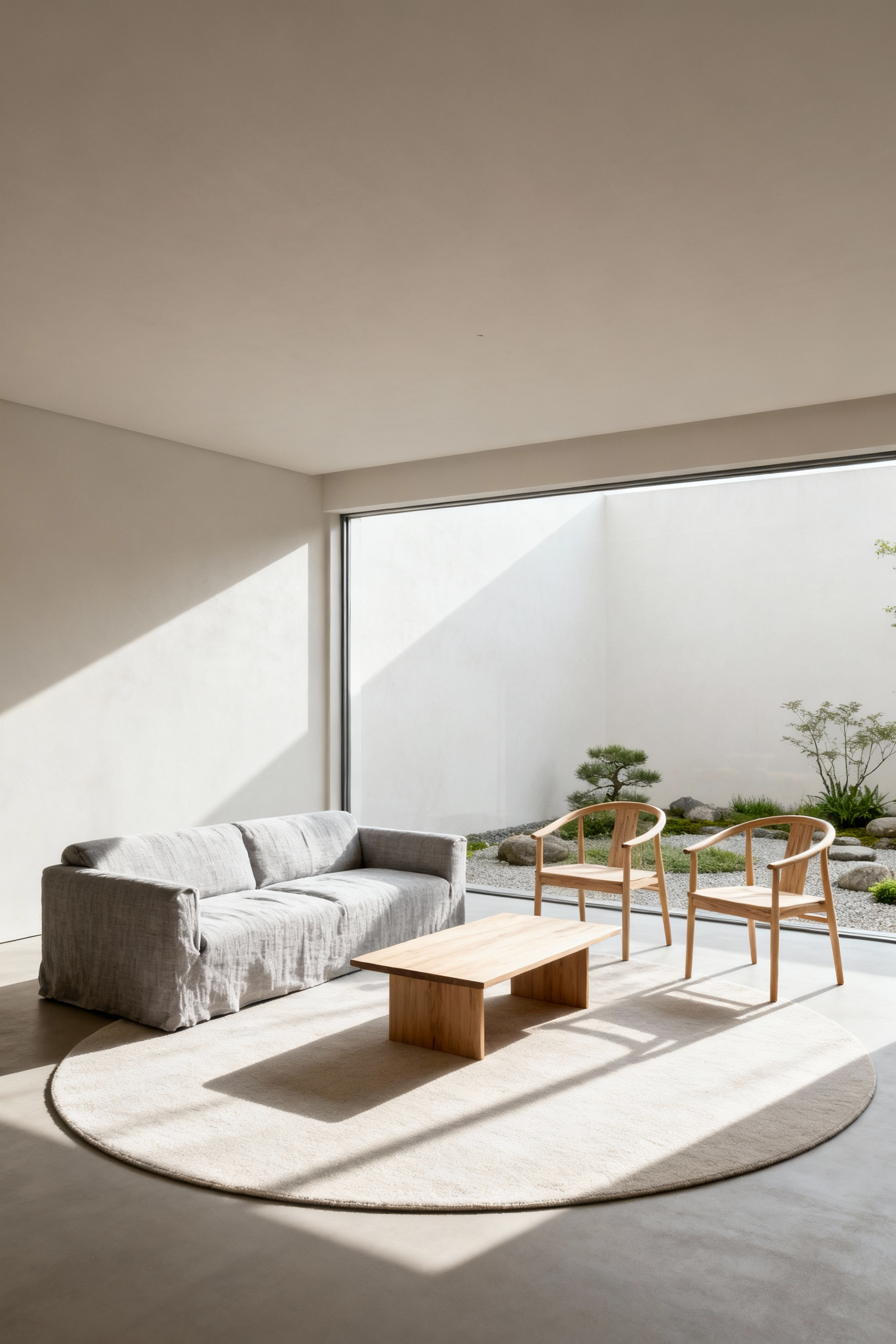
These groupings act like ‘islands of purpose’ within the larger room, defined by the potent space—the Ma—between them. This allows for clear pathways and a feeling of order, making the room feel both inviting and intuitively easy to navigate.
12. Maximizing Verticality for Visual Expanse
Drawing the eye upward creates an illusion of a larger, airier space. Use tall, slender bookcases or floating wall shelves to utilize vertical space without consuming the floor. This technique lifts the room’s energy and prevents it from feeling heavy or constrained.
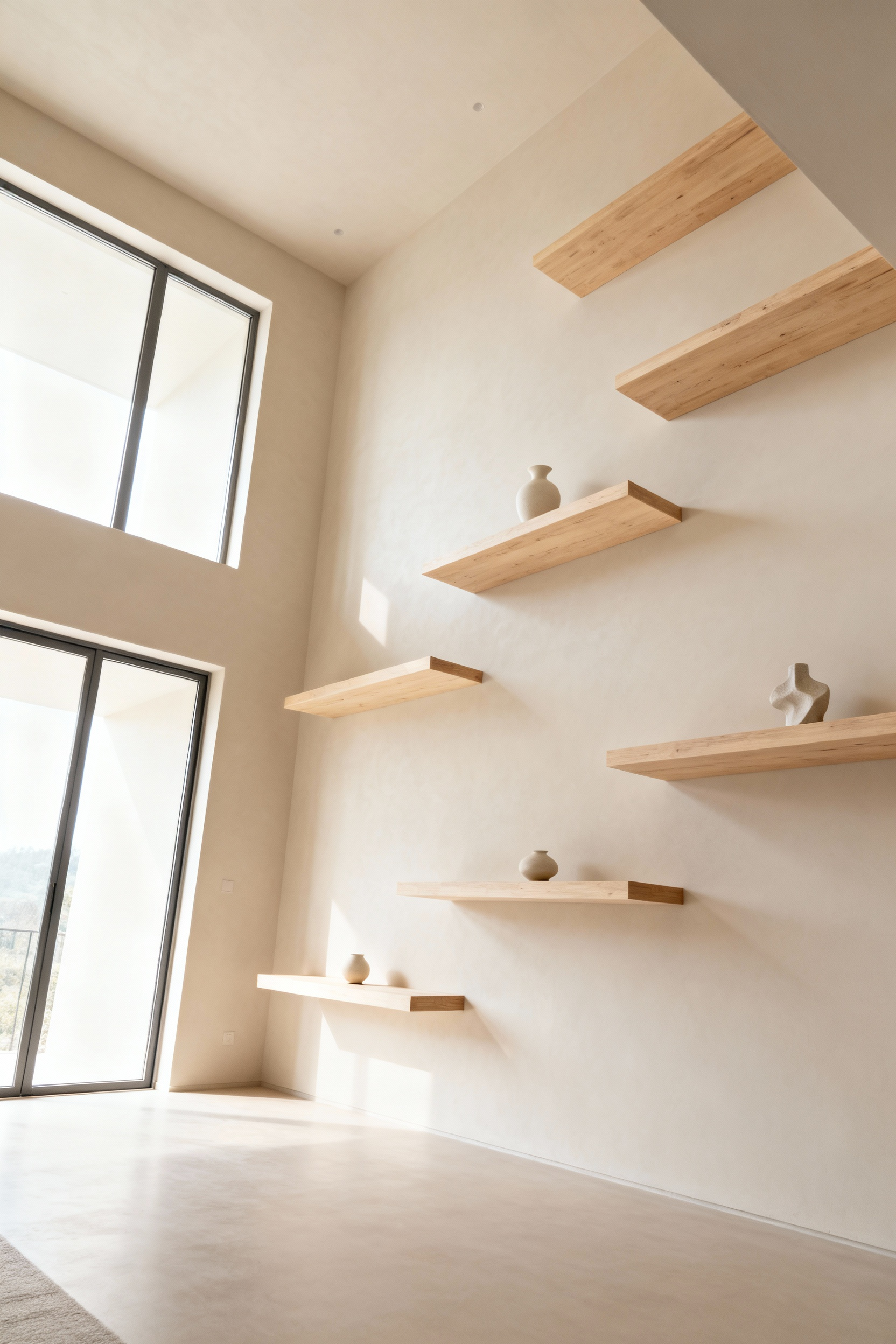
The key is to keep these elevated surfaces sparsely decorated. A few curated books and a single beautiful object are enough. By moving storage and points of interest upward, you free the horizontal plane, creating a profound sense of openness and clarity below.
13. Calibrating a Single, Quiet Focal Point
A serene room gives the eye a place to rest. Instead of having multiple elements competing for attention—a loud piece of art, a busy rug, and decorative clutter—choose one primary focal point. This could be a beautiful view from a window, a minimalist fireplace, or a single, significant piece of art.
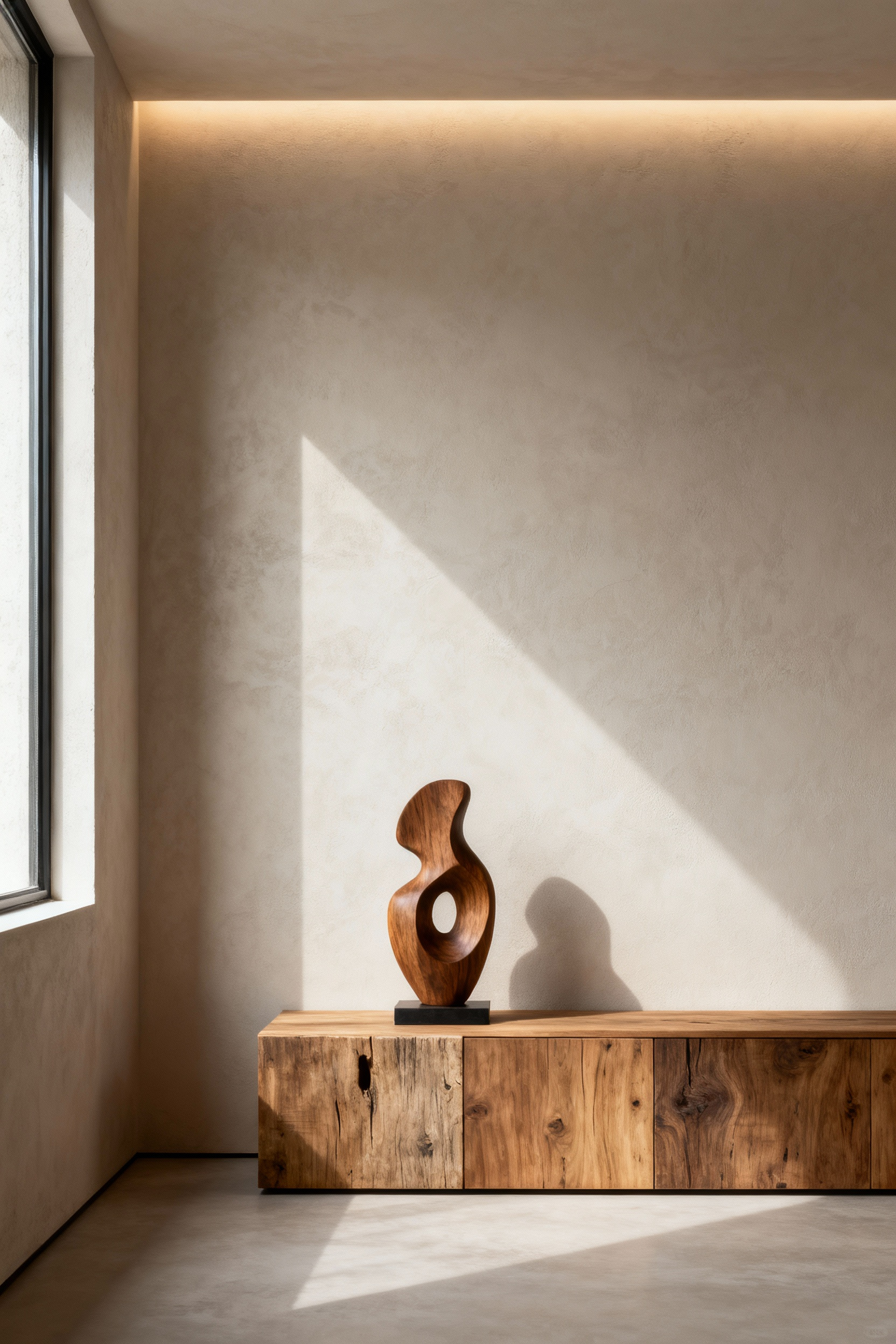
Everything else in the room should quietly support this anchor. What this does is create a natural sense of hierarchy and order. I learned this when studying traditional teahouse design; the tokonoma alcove provides a single, contemplative focus, allowing the mind to settle.
14. Eliminating Peripheral Noise with Integrated Storage
Visual clutter is mental clutter. The most effective way to maintain serenity is with smart, concealed storage. Integrated, built-in cabinetry that blends seamlessly with the walls is the ideal, hiding the necessities of modern life—from electronics to everyday items—out of sight.
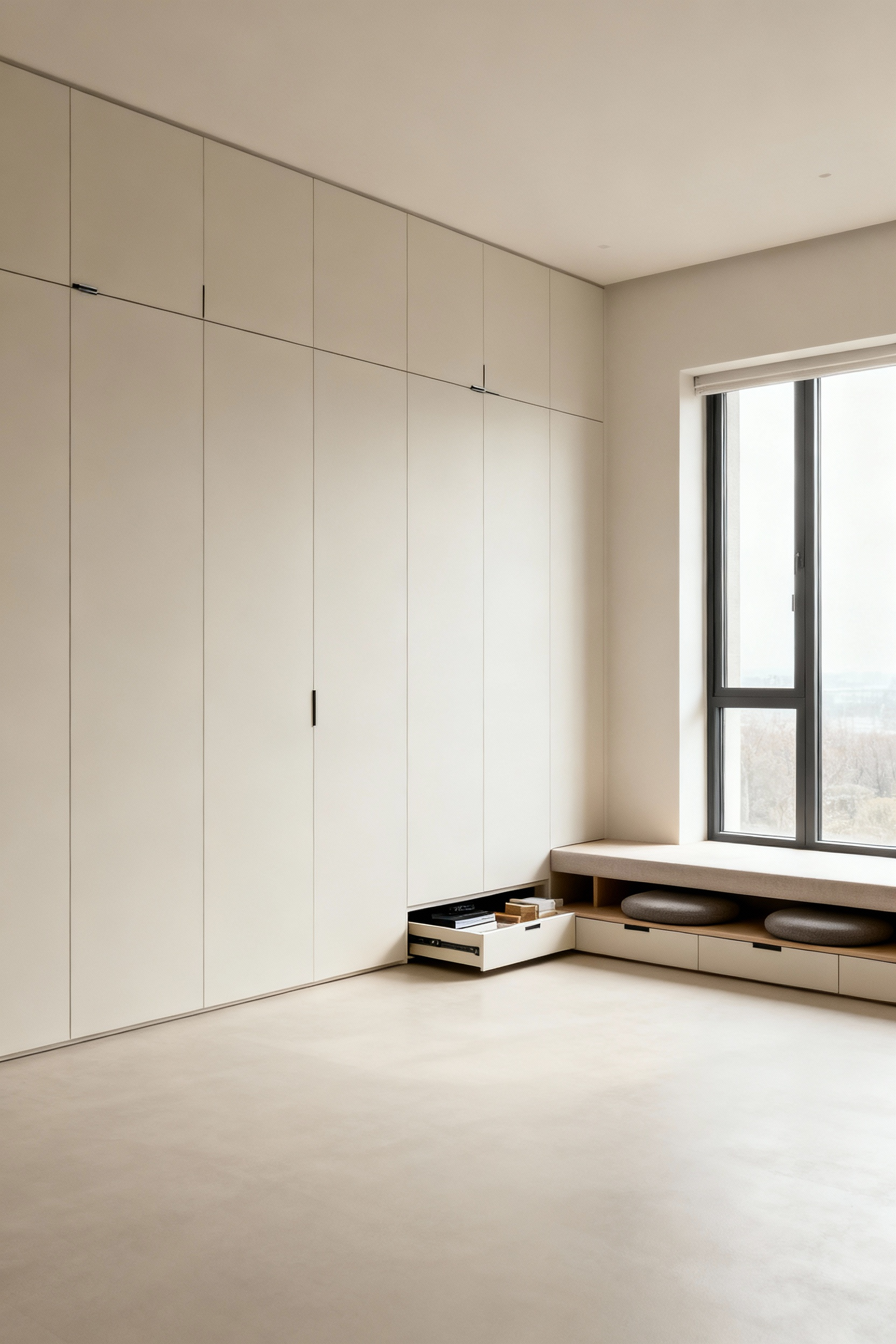
When storage is designed as part of the room’s architecture, it doesn’t feel like an addition. It creates a smooth, uninterrupted surface that is profoundly calming. This allows the few objects left on display to hold their own with quiet confidence.
15. Designing Circadian-Aligned Lighting
Just as we shape natural light, we must be intentional with artificial light. Our bodies are attuned to the sun’s daily cycle. Modern lighting can support this rhythm. Use warm, dimmable lights in the evening to signal to your body it’s time to rest, and brighter, cooler task lighting for daytime focus.
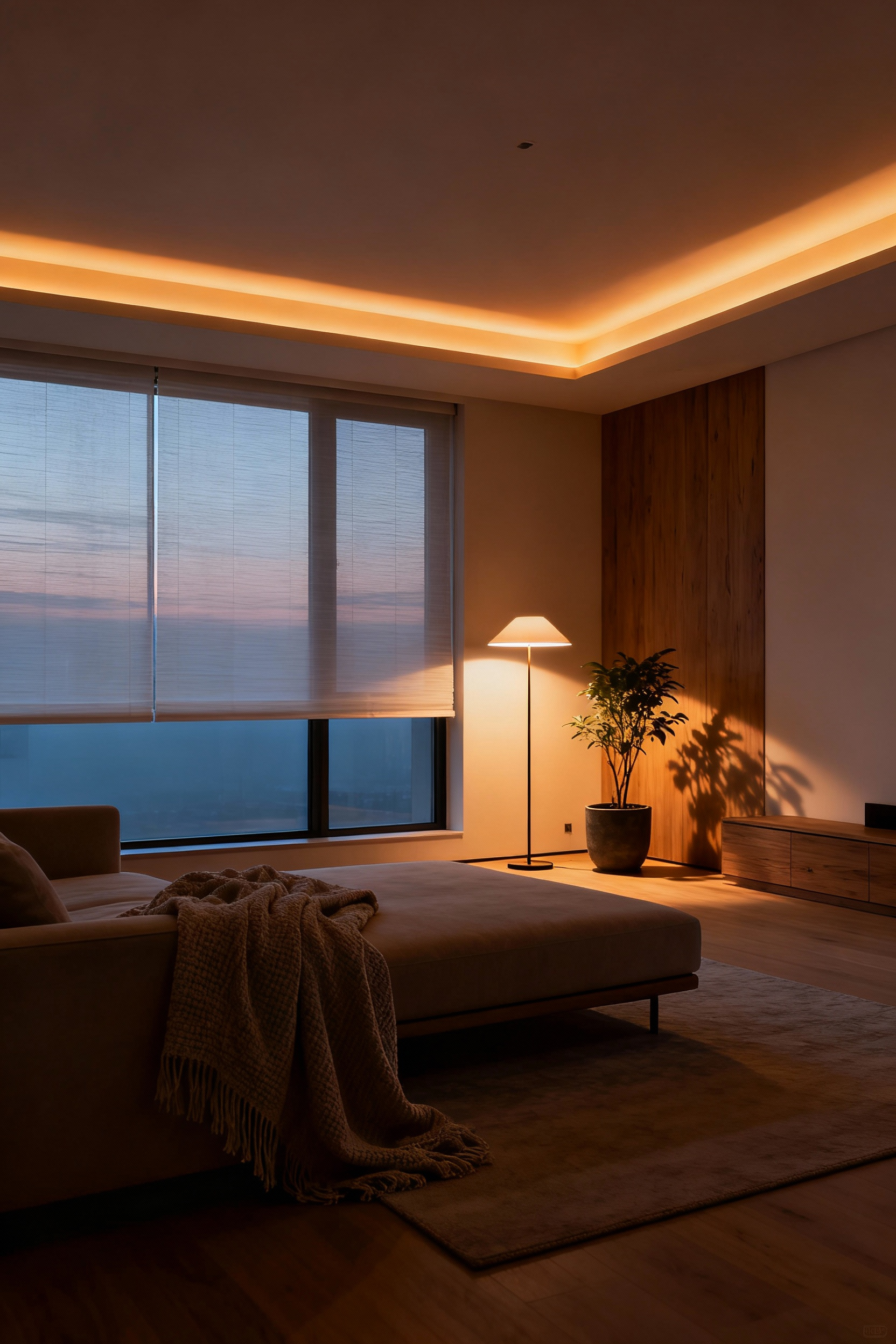
Layering is crucial. An overhead ambient light, a focused reading lamp, and a subtle accent light create a flexible and supportive environment. This is functional aesthetics at its best—a design choice that enhances not only the room’s beauty but your well-being.
The Practice: Sustaining Serenity as a Way of Life
A tranquil home is not a destination; it is a practice. It requires ongoing attention and a conscious relationship with the things we live with. The final principles are about the gentle, daily rituals that sustain the peace we have so carefully cultivated.
16. The Daily Ritual of O-soji—Mindful Tidying
In Japan, O-soji is the traditional year-end deep clean, but its spirit can be adopted as a daily ritual. This is not a chore, but a meditative practice of resetting your space. Taking five minutes each evening to put things away, wipe surfaces, and fluff cushions is an act of respect for your home and yourself.
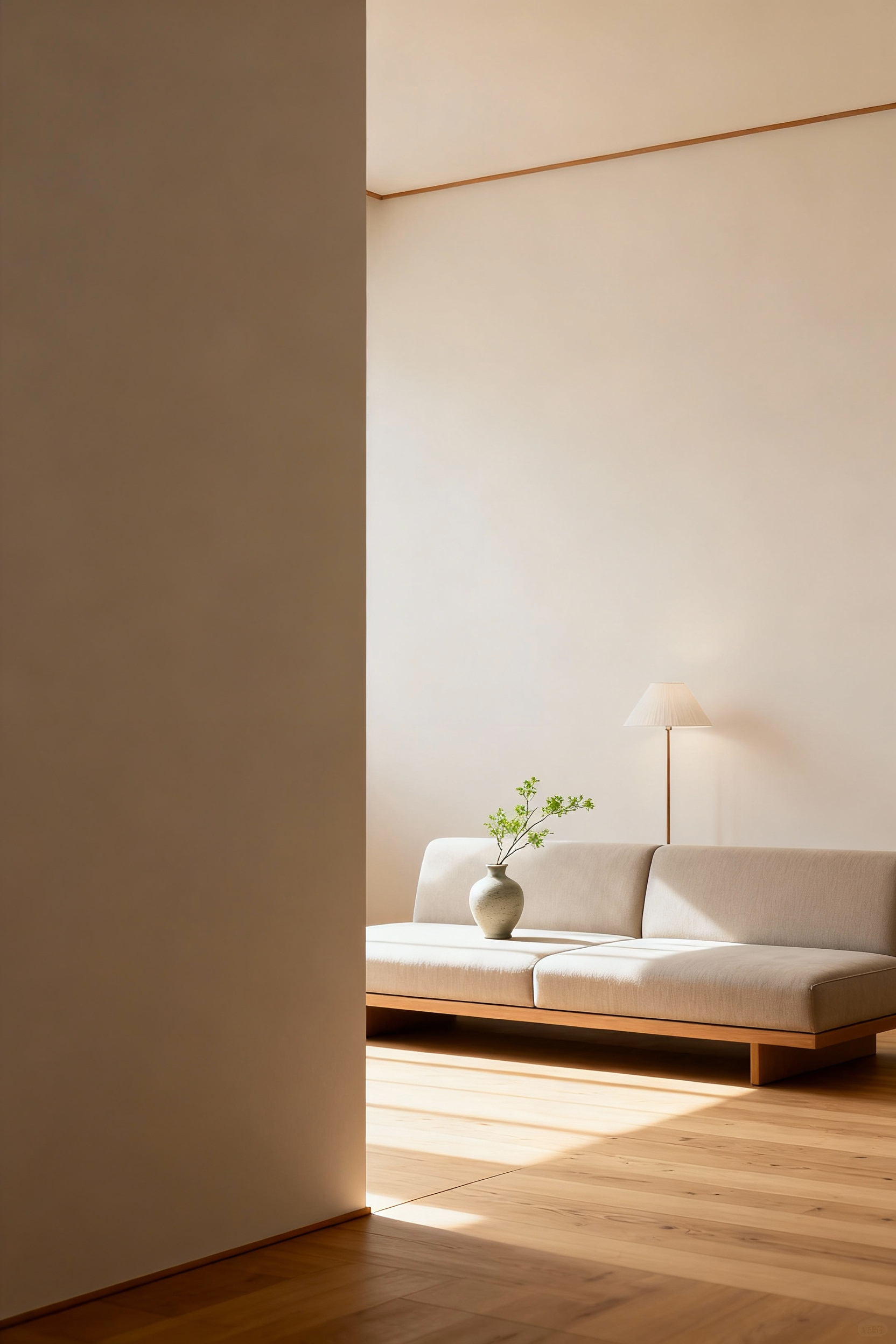
This small ritual prevents the slow accumulation of disorder. It purifies the space for the day ahead and becomes a grounding moment of mindfulness, reinforcing the connection between external order and internal peace.
17. Embracing Wabi-Sabi—The Beauty of Imperfection
A home must be lived in. Wabi-sabi is the philosophy of finding profound beauty in imperfection, transience, and the natural process of aging. It celebrates the crack in a ceramic cup, the patina on a wooden table, and the softening of a linen cushion.
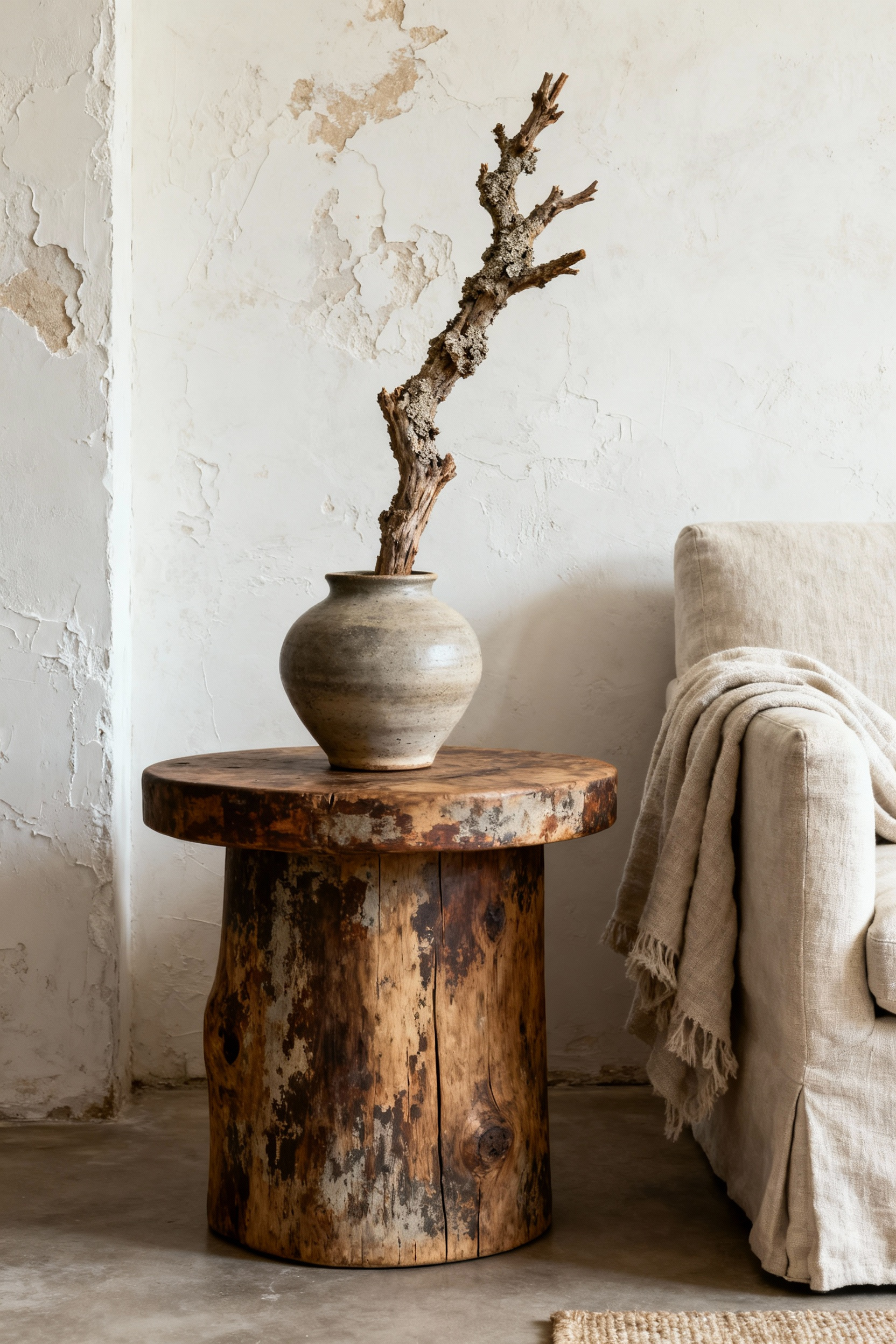
Embracing wabi-sabi frees us from the anxiety of maintaining a perfect, museum-like space. It allows our homes to evolve with us, telling the story of our lives through the gentle marks of use. A space with wabi-sabi feels authentic, soulful, and deeply comforting.
18. Rotating Curated Objects to Maintain Freshness
Familiarity can make us stop seeing the beautiful things we own. To keep your connection to your curated objects alive, practice rotating them. Display a few cherished items at a time, keeping others in storage.
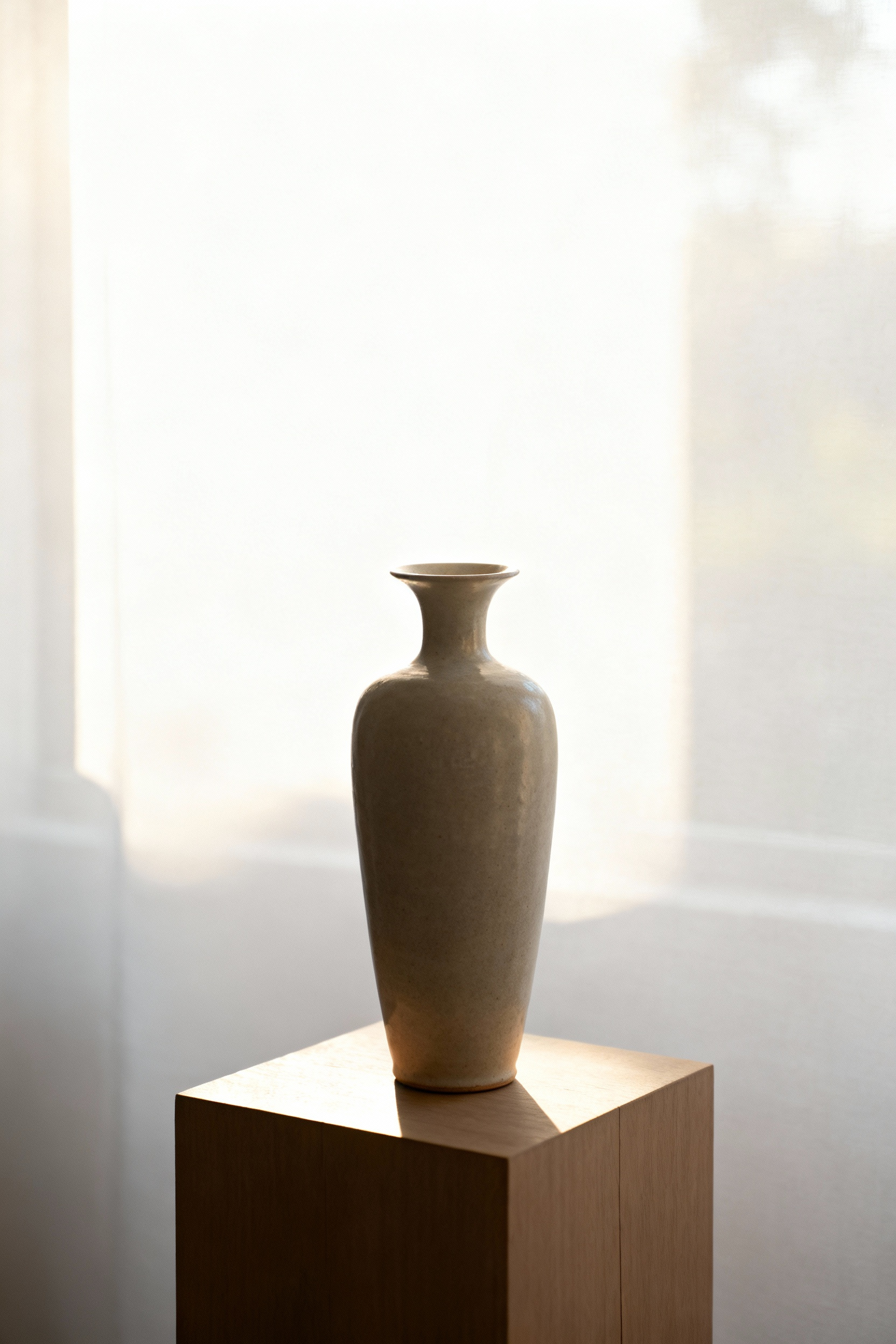
Every few weeks or with the change of seasons, switch them out. This act of reintroducing an object allows you to see it with fresh eyes, appreciating its beauty anew. It ensures your sparse environment never feels static, but remains a place of quiet discovery.
19. Prioritizing Deep Comfort and Ergonomics
True simplicity must be comfortable. A beautiful chair that you can’t sit in for more than ten minutes violates the core principle of a home as a sanctuary. Functional aesthetics means that form must serve human well-being.
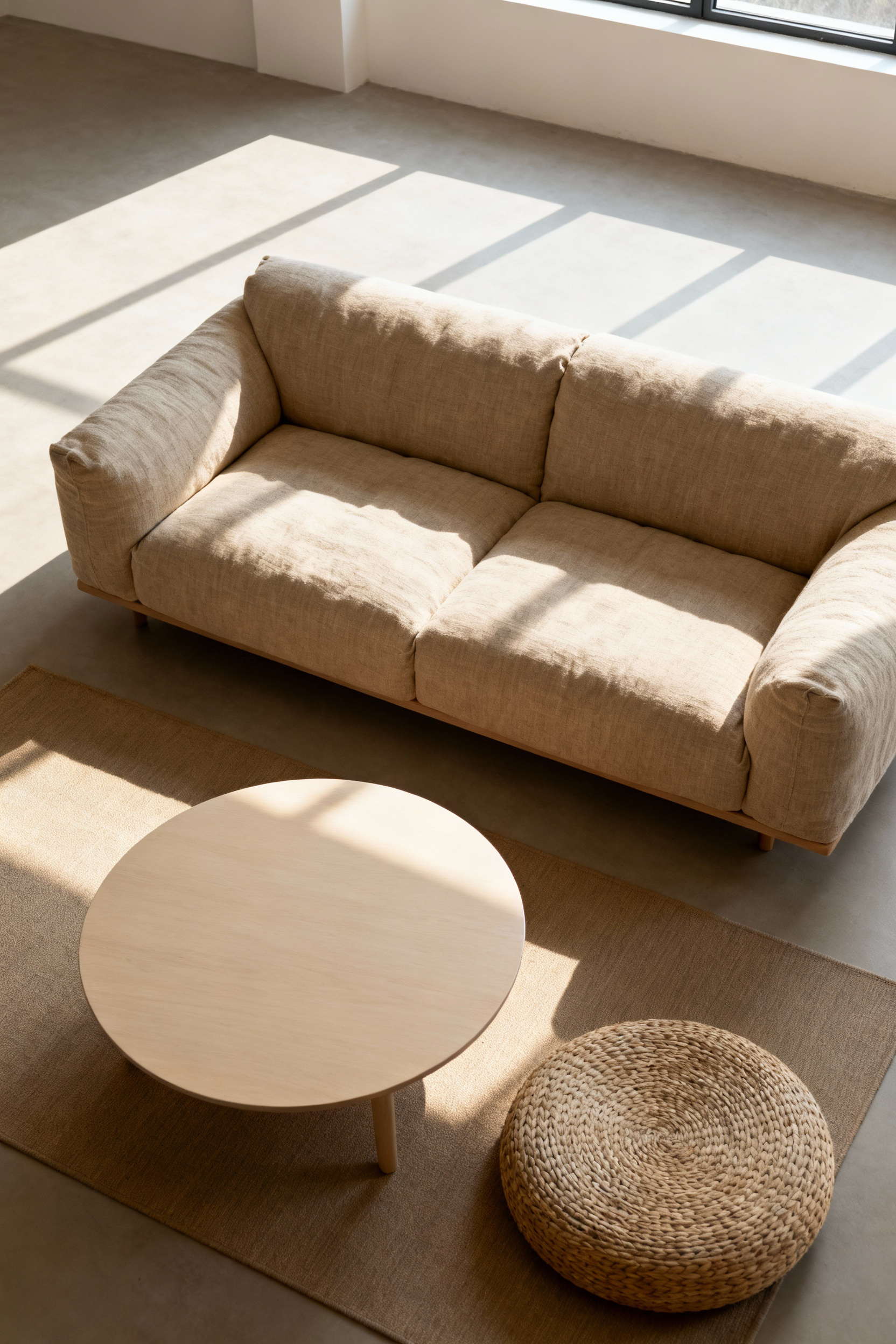
Invest in furniture that supports your body. A sofa with the right depth and support, a chair that encourages good posture—these are the foundations of a room designed for living, not just for looking at. Comfort is a form of quiet luxury that enhances every moment spent in the space.
20. Establishing an Intuitive Decluttering System
Finally, maintaining clarity requires a gentle but constant vigilance. An intuitive decluttering system is not a one-time purge, but an ongoing conversation with your belongings. Regularly ask of an object: Does this still serve me? Does it bring me peace? Is it truly beautiful to me?
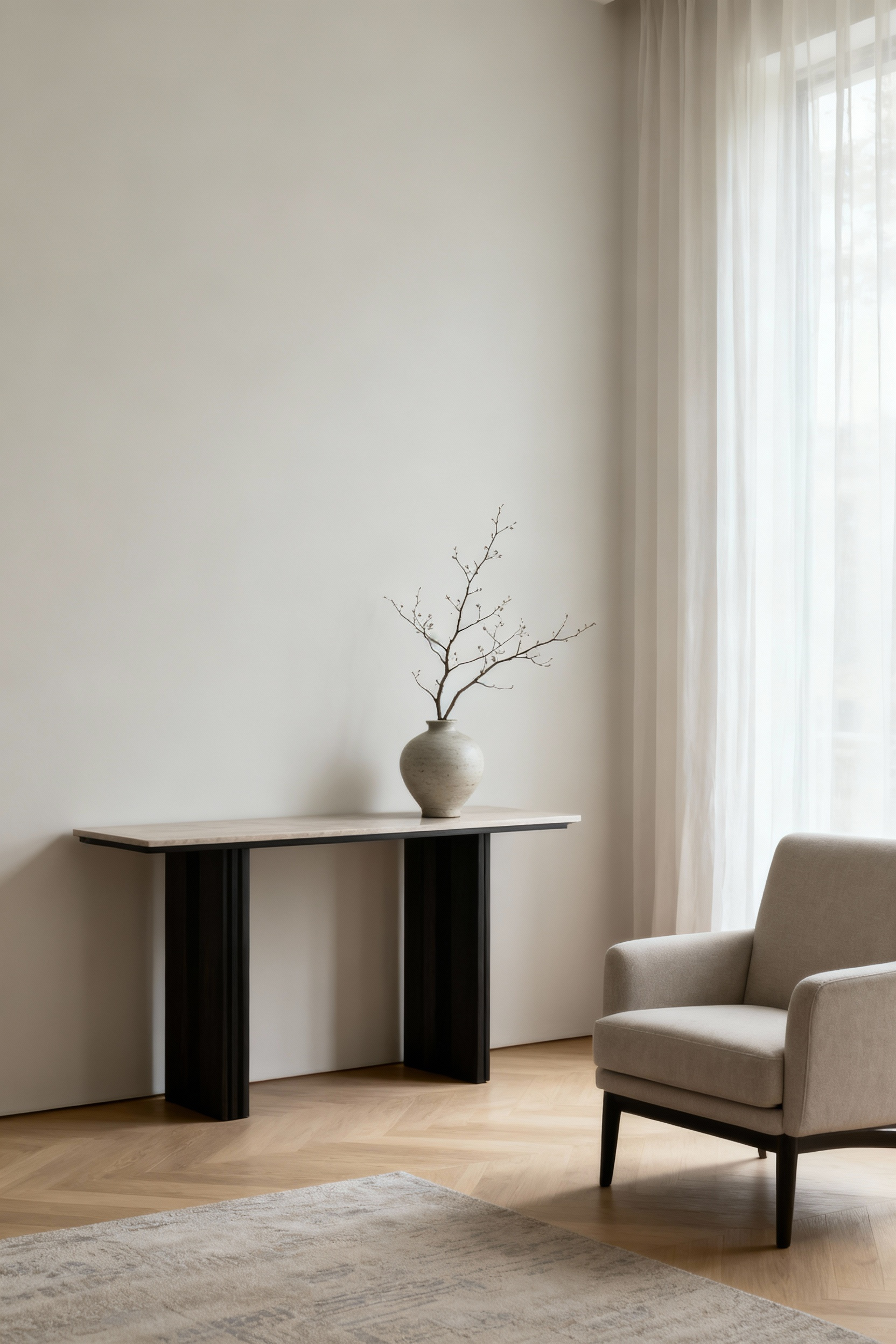
Letting go of what no longer resonates is as important as choosing what to bring in. This practice ensures your home remains a pure reflection of who you are now, an evolving sanctuary that supports your journey through life with grace and simplicity.
Conclusion
We have walked through twenty contemplative paths, each leading toward the same truth: a simple living room decoration is not a style to be acquired, but a state of being to be cultivated. It begins with philosophy and finds its expression in the mindful selection of materials, the intentional shaping of space, and the daily rituals that sustain its peace. This is the essence of creating a home that serves as a quiet mirror to the soul.
Remember that this journey is your own. These principles are not rules, but guides to help you listen more closely to your space and to yourself. Let your home be a place of breath, of meaning, and of profound, simple beauty. Let it be a testament not to what you own, but to how you choose to live.
